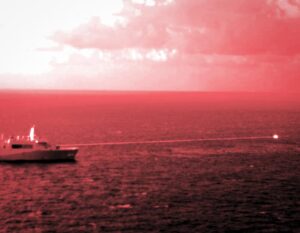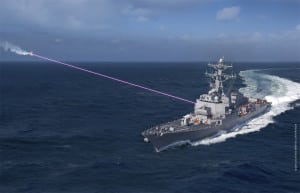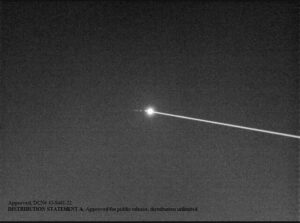SAN DIEGO —An Office of Naval Research (ONR) official this week said the Navy is moving “very cautiously” on directed energy (DE) laser weapons because the eventual first program of record could cost up to $1 billion.
“The Navy is definitely interested. However, they are not at this point willing to press the ka-ching machine and get a lot of cash because it’s going to be about a billion dollars, roughly give or take, to field the first true program of record laser. And that’s why we’ve been experimenting so much,” David Kiel, Director of the Directed Energy Warfare Office at ONR, said during a Feb. 14 panel at the annual WEST 2023 conference here, sponsored by AFCEA International and the U.S. Naval Institute.

He said the Navy is currently probably leading the other services in directed energy weapons, but it is proceeding methodically and carefully due to some internal skepticism of laser utility.
“You’ve got to overcome the people who think that they don’t work…and that’s why we’ve been pushing really hard to field these prototype systems and overcome some of that, I don’t want to say resistance,” Kiel continued.
He explained the current Navy laser efforts include the single Lockheed Martin [LMT] high energy laser with integrated optical-dazzler and surveillance (HELIOS) system integrated on the Arleigh Burke-class destroyer USS Preble (DDG-88), five AN/SEQ-4 Optical Dazzler Interdictor, Navy (ODIN) systems installed on other destroyers and three more planned, and the 150kW-class Solid State Laser Technology Maturation (SSL-TM) prototype Laser Weapons System Demonstrator (LWSD) installed on the USS Portland (LPD-27). Previously, an earlier 30kW version of the LWSD was tested on the USS Ponce (LPD-15).
The 60+ kW-class HELIOS system was delivered to the Navy last August. It is geared to disable unmanned aircraft systems and small boats while also doubling as a counter-UAS intelligence, surveillance and reconnaissance (ISR) dazzler capability that feeds additional ISR data into the ship’s combat system. At a high power setting it directly attacks threats while a low power setting is the dazzler, which works to reduce or confuse a target’s ISR systems (Defense Daily, Aug. 18, 2022).
Kiel said HELIOS is set to go through qualifications this summer and the SSL-TM LWSD was recently used on a deployment across the 4th, 5th and 7th Fleet regions. While the latter could not survive another deployment, sailors operated it for a significant time and “we solved numerous policy and [test and evaluation] issues.”
Kiel also highlighted the Navy’s High Energy Laser Counter-ASCM Program (HELCAP) program. According to the Navy’s fiscal year 2023 budget request, HELCAP aims to speed up the development, experimentation, integration and demonstration of “critical technologies to defeat crossing Anti-Ship Cruise Missiles (ASCM) by addressing the remaining technical challenges.”
Those challenges include atmospheric turbulence, automatic target identification, precision target tracking with low jitter in high clutter conditions, advanced beam control and higher power HEL development.

Kiel said HELCAP seeks to move the Navy development to the next generation of DE laser weapons with a 300+kW source.
“Two contractors successfully demonstrated 300kW with thousands of seconds of total time of lasing with no failures. Never seen a missile do that. And in realistic well-timed type scenarios, 30 seconds on-30 seconds off-30 seconds on – for hundreds of seconds. So they’re very reliable. So I do believe this is a revolution.”
The 300kW lasers actually require 600kW to one megawatt in power to shoot because so much is lost in transferring energy, firing the weapon, and the loss of energy in the atmosphere as the laser shoots.
Kiel noted the Navy has been working on laser weapons since the 1980s. In more recent years, the industrial base developed much cheaper, more reliable and rugged lasers, allowing ONR to get these systems to the fleet in limited quantities to help validate their models and simulations.
However, another panelist questioned “the ability of a laser system to meaningfully impact the anti-ship cruise missile fight in the near- to mid-term. We’re looking at relatively short ranges… in terms of effectiveness.”
Lt. Cmdr. Joseph Lewis, Integrated Air and Missile Defense Warfare Tactics Instructor at the Surface & Mine Warfighting Development Center Fleet Training Pacific, estimated a 600 knot missile travels about one mile every 10 seconds while the current lasers with a two to three mile range require a five to 10 seconds dwell time to defeat the missile. This means he does not think laser weapons will not have enough time to defeat cruise missiles for the near future.
“So even as a complement to kinetic defensive systems, I question the efficacy of lasers and meaningfully impacting that in the near term.”
Kiel underscored space on a ship like the Arleigh Burke-class Flight IIA destroyer is a major limiting factor in installing laser weapons on ships now. Not only does the Navy need to fit the laser weapons themselves, but is also planning to use batteries as the “preferred solution” to discharge the energy needed.
Kiel said the Navy is “scared to death” of the lithium ion batteries popular in electric cars due to the fire risk, but the service is looking into a different type of battery to use on ships.
“There is another very old battery technology that people have kind of forgotten about and that’s nickel-zinc. And it’s actually better for a laser than for cars, because it has a higher power density and that’s what’s limiting us. We need a megawatt on and off quickly. And for lithium ion batteries, you have got to make a much bigger one because they’re very energy dense and not as power dense.”

He noted the HELCAP effort is using nickel-zinc batteries.
Kiel also said the Navy needs to find creative thermal solutions to help cool the laser systems. He suggested an idea to use the 3,000 gallons of water on a ship used for the air conditioning can help cool down a laser for 100 seconds and only raise the water by about two degrees centigrade. The batteries could also be recharged by temporarily stripping some non-vital loads for a ship like aft steering.
“NAVSEA is seriously looking at that as the heat, thermal magazine for ships. We are working very hard to try to minimize the…difficulty of putting lasers on ships.”
Lewis argued the Navy also needs to acknowledge that regardless of the type of battery used “we are sub-optimizing some of our systems, whether you take out from the five-inch magazine or [Vertical Launch System] … there’s something we’re now not doing because we put a giant battery on the ship. So there’s a trade off here and as it relates to cooling and changing how the system is currently set up. That’s not a quick process. It’s not an automated process. It’s not an easy process.”
He also said the laser systems have to be made easier to operate correctly, because it will be done by young sailors.
“So we have to understand that, as NAVSEA and lots of really smart people figure out how to solve this problem – but it’s being implemented by people that are 18 to 22. And we have to make it easier to do. And if it’s hard, it’s not happening well.”